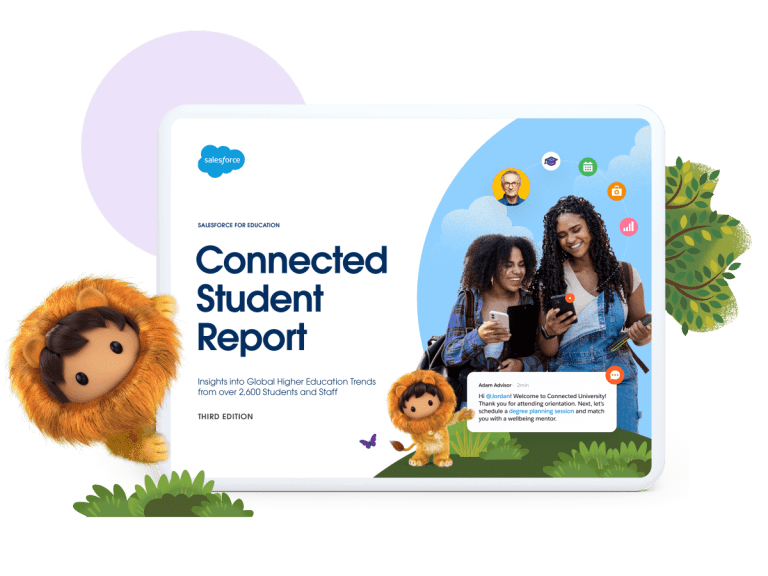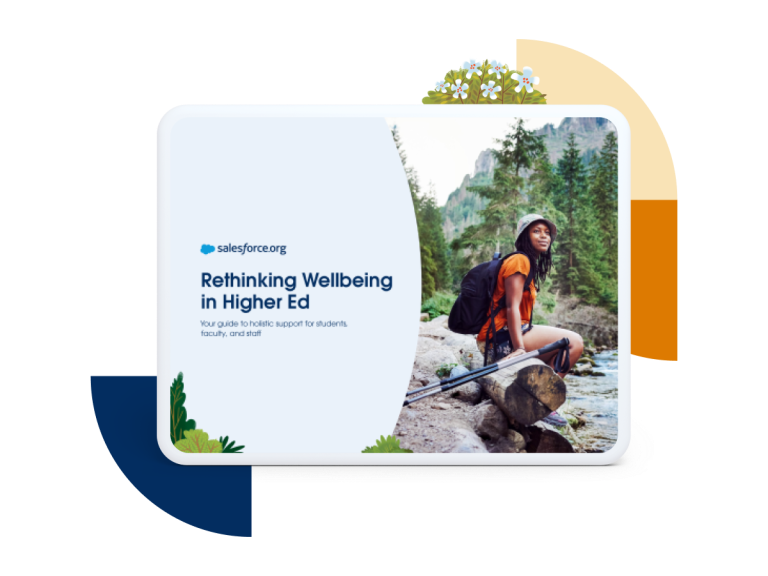One of the most prolific effects of the pandemic was the creation of new personal and professional tech-centered environments that supported a variety of remote and hybrid experiences. When students returned to campus post-pandemic, colleges and universities saw a palpable shift in student expectations regarding their higher education experience.
While learning remotely, students across the country became comfortable accessing everything from food to transportation with a few taps on a mobile device, and they began to expect the same seamless experiences from their academic institutions.
To retain students, colleges and universities must meet students where they are, for example on their mobile devices, and make it easy to find and access flexible course offerings, learning environments, career planning, and financial support.
“Student expectations around support services provided by their institutions has increased dramatically,” Sarah Todd of Griffin University said in the third edition of the Connected Student Report. Students will remain engaged and positive if institutions can meet and exceed these expectations. Todd says, “Engaged and positive students are more likely to continue their academic studies, make better academic progress, and consider further educational opportunities at graduation or later on when their careers develop – all of which contribute to student retention.”
This article offers several focus areas to help increase student retention rates today.
-
46%of students who feel connected also had a great university experience.

Report
Connected Student Report,
Third Edition
Unpack the latest research findings on student retention, including what students need to connect and thrive.
How to improve student retention
To improve student retention, institutions must reimagine the student experience through a new lens that puts the student at the center.
“It feels like the pandemic accelerated the need for flexibility that had not always existed,” said Kedra Ishop, Vice President for Enrollment Management at the University of Southern California, in the third edition of the Connected Student Report. More than half (57%) of higher education staff members surveyed in the report agree, anticipating that flexible learning will increase in the near future.
That flexibility can be developed by combining continuous, proactive, and personalized student experiences with holistic advising.
1. Continuous, proactive, and personalized experiences increase student retention
Deliver personalized experiences
69% of students who reported having a great educational experience agree that their institution provided a personalized experience tailored to their needs, according to the Connected Student Report. Additionally, 70% of students with a great onboarding experience say they had a great university experience.
Combine customized student experiences with onboarding at first-year orientation, and institutions can drive student retention and long-term success from the beginning. For example, institutions can strategically use data to personalize welcome emails and videos. Segmenting communications by dorm selection, major, or extracurricular interests can make students feel immediately connected and comfortable in their new environment.
Additionally, institutions can enable students to choose the channels they prefer to engage with. Students are more likely to stay on track and ask for help when they need it if they can communicate comfortably and conveniently. Meet students needs anytime, anywhere with chabots, SMS, email, self-servicing knowledge articles, or a digital one-stop student services center.
Foster flexibility and accessibility
An easy win for institutions is implementing flexible, virtual offerings where only in-person opportunities were available before. Virtual advising, virtual (or hybrid) classes, and telehealth wellness checks offer access to important resources and services from anywhere. Students with less flexibility, such as those who are parents or work while enrolled, will be incredibly grateful for these offerings.
Consistency in relationships with advisors, faculty, alums, or peer mentors is also essential for student wellbeing and student retention. Students appreciate a trustworthy, go-to network of support when they feel discouraged or lost. Advisors can use email or text communication campaigns to proactively reach out to students and help familiarize them with additional resources and amenities available.
Research from the Rethinking Wellbeing in Higher Education guide shows that when advising is more accessible, students are more likely to reach out — not only for academic support but for mental health, stress management, and overall wellbeing. More than half of students (51%) look for this support on their school’s website.
Financial support is student support
When asked, “What resources do you need from your university to be successful as a student?” in 2022, 40% of students answered, “more financial aid” (up from 34% in 2021, according to the Connected Student Report).
Students also desire assistance balancing their academic, work, and personal lives, all of which are bound and determined by their ability to afford their education. Navigating the complex world of financial aid, for instance, can be overwhelming and time-consuming, which is difficult for students who are already balancing studies and work or even parenting.
Students need administrative staff who can guide them through financial obstacles throughout their education journey. Staff should consider the following questions when engaging with students seeking financial aid support:
- If a student’s balance is unpaid after the due date, who is following up to see if help is needed?
- Does the financial aid office, which is likely equipped to discuss solutions, know that this occurred?
- Is financial stress causing the student to look for additional outside work, such that they have less time to complete assignments?
- What type of support does this student need and what accommodations can be made to drive their success?
Students who feel supported holistically, from financial aid to academics and wellbeing, are more likely to feel a sense of belonging to their institution and remain engaged throughout their education journey.
Expand career services
According to the Connected Student Report, nearly half (47%) of students reported selecting their institution for career prospects, but only 11% felt prepared for work post graduation. Institutions must begin communicating the long-term value and career opportunities linked to a degree even before students arrive at orientation. Helping students feel prepared for the future of work with expanded career services can improve their overall experience and increase retention rates.
Students surveyed in the Connected Student Report who felt well-prepared for the world of work were four times more likely to report having a great university experience. Institutions can drive greater impact with expanded career services that:
- Create a mentorship program that starts on Day 1.
- Pair students with alums who shared the same major and can offer support on everything from resume writing to networking.
- Schedule a regular “career chat” with an academic advisor to ensure students are on the right track.
- Build relationships with nearby organizations to foster student internship opportunities.

“Ultimately our goal is really to help each and every student achieve their greatest potential. Part of student success, especially for our student experience advocates, is creating a sense of belonging that feels connected but also unique to each individual student.”
Miro Humer,
Vice President & Chief Information Officer
Case Western Reserve University
2. Offer students holistic advising to increase retention
Students need more than just academic or financial support in order to succeed. They need their institution to acknowledge that there are many factors shaping their education journey. Institutions can support their students and anticipate their various needs by offering holistic student advising. The best way to provide such support is to offer holistic student advising that strengthens student engagement, allows deeper student-advisor connections, and improves internal collaboration efforts. This builds a path to student success that will reduce attrition and increase overall retention rates.
Cross-departmental communication is key
Institutions are reimagining the student experience with seamless, interdepartmental, equitable support throughout the student journey from recruitment and admissions to enrollment and onboarding.
With traditional, legacy student support systems, multiple stakeholders often work in silos, making student support networks ineffective. Advisors and professors may never have the opportunity to communicate or collaborate about vital information that could prevent a student from falling through the cracks.
Today, integrated platforms enable different departments (academic, health, career, advising) to collaborate and create a complete support system students can easily navigate. Institutions need to offer seamless support services from anywhere that bring together the right people to drive proactive student outreach at scale.
Use a single platform for seamless student support
Tom Green, Ph.D., a higher education industry advisor at Salesforce, in Connecting the Dots and Data to Improve Student Success states that the personalization students crave begins with integrated data and insights. He points out that many institutions have access to student data that indicate action is needed but require help determining who will best handle the issue across campus. Green recommends the following for institutions:
- Set up a care team that could include, but isn’t limited to, someone from advising, health services, counseling, or financial aid.
- Have a unified data set that can join multiple data sources together to have a 360-degree view of students.
- Identify what data might need to be included and create a plan for how to collect insights through engagement polls or surveys. When enough data is collected throughout the student experience, institutions can identify patterns and changes to inform future decisions.
“The goal,” Green says, “is to connect the blind spots of the student experience to ensure every student gets what they need when they need it.” For instance, with the right tools and student success technology, email triggers can deliver timely outreach on everything from new course offerings that align with a student’s major to wellbeing tips and how to discover relevant internships with local companies.. When those insights are aggregated and leveraged, schools can provide proactive, highly-personalized experiences — the groundwork for effective student retention efforts.
The Total Economic Impact™ of Salesforce Education Cloud
See how Education Cloud improved student retention by 6.8% with an integrated platform to centralize information, streamline services, and improve communication.
Create a feeling of belonging to retain students
A student’s orientation and first few weeks on campus can determine their sense of belonging and overall institutional experience, so the stakes are high for universities to have a connection strategy.
According to the Connected Student Report, students with a great onboarding experience are 35 times more likely to have a great overall university experience. Additionally, there’s a 73% correlation between a positive onboarding experience and a positive overall university experience, showing that belonging is foundational for student retention.
Introductions to an institution’s culture beyond academics can help create direct pathways for students to feel at home on campus. Washington University in St. Louis offers first-year students an in-depth introduction to their city called “In the Lou.” This onboarding experience during orientation extends beyond tourist information students can find on YouTube and instead dives into the city’s neighborhoods, politics, and history. It’s the first step toward helping students discover enriching experiences outside the classroom.
Connecting students with local cultures or people with similar interests is a good start, but focusing on diversity, equity, and inclusion (DEI) is also needed. Meeting with other students, faculty, and staff from similar backgrounds can create an instant sense of community and belonging.
According to Connecting the Dots and Data to Improve Student Success, social integration efforts should go beyond traditional-aged students joining student clubs. Institutions should consider how adult learners need to bond with other adults. Faculty engagement, a form of social integration, and how students feel “heard,” “seen,” and “accepted” by faculty and staff are also critical factors to consider. While there is no one-size-fits all model, being mindful of how similar groups of students can connect with each other both on and off campus is key to driving their success.
Technology can also build student connections. Email or text communications from the institution can inform students about upcoming events and gatherings. Student data collected from emails — such as open and click-through rates — can help identify students with similar interests for future face-to-face social events and networking.
Case Western University launched a strategic, data-based initiative to increase retention, satisfaction, and graduation rates. Their initial actions focused on using integrated data and insights to connect students with personalized experiences that ultimately helped them achieve their goals in the classroom, labs, extracurricular activities, or experiential learning.
According to the Connected Student Report:
-
86%of students who have a great experience reported having easy access to data and resources.
-
82%of students who have a great experience reported having services available via mobile.
-
60%of students who have a great university experience reported having personalized engagements tailored to their needs.
Provide proactive tools and systems for student wellbeing
Mental health and wellbeing issues on campuses are on the rise. And while higher education leaders are doing more to put measures in place, the institutions prioritizing wellbeing will ultimately see enhancements to their student retention rates.
In just six years, student anxiety in higher education institutions jumped from 17% to 31%, according to a study by the Healthy Minds Network and the American College Health Association.
To combat this, colleges need to know — are their students getting enough sleep? Eating healthy? Exercising? Access to wellbeing resources like nutritionists, a gym, and mental health professionals like psychiatrists can be woven into student retention plans to support students throughout their higher education experience holistically.
These wellbeing strategies can begin during orientation. Universities can proactively reach out to students and address how to manage anxiety and, more importantly, how to ask for help. More readily available wellness checks, for example, could flag students suffering from addiction, eating disorders, or food insecurity. Combine those checks with consistent follow-up communications with helpful articles and blogs, or connect students with student success coaches, advisors, or alumni mentors who can drive the “we’re here for you” message home.
Recognizing red flags proactively and giving students immediate attention helps those at-risk and lessens the likelihood of a drop-out or transfer.

Guide
Rethinking Wellbeing in Higher Education
Learn best practices for giving the holistic support your students need.
To retain students and remain competitive, colleges and universities must meet students where they are. Institutions can do this by expanding student resources and pairing continuous, proactive, and personalized experiences with holistic advising. When students have access to the resources they need from anywhere — no matter how overwhelmed or stressed they may be — they feel supported. Supported students are more likely to have a great university experience and complete their degrees, ultimately driving retention rates up.
Learn about Student Success Software from Salesforce
Having the right technology can make all the difference in how your institution streamlines student support and boosts retention rates.
